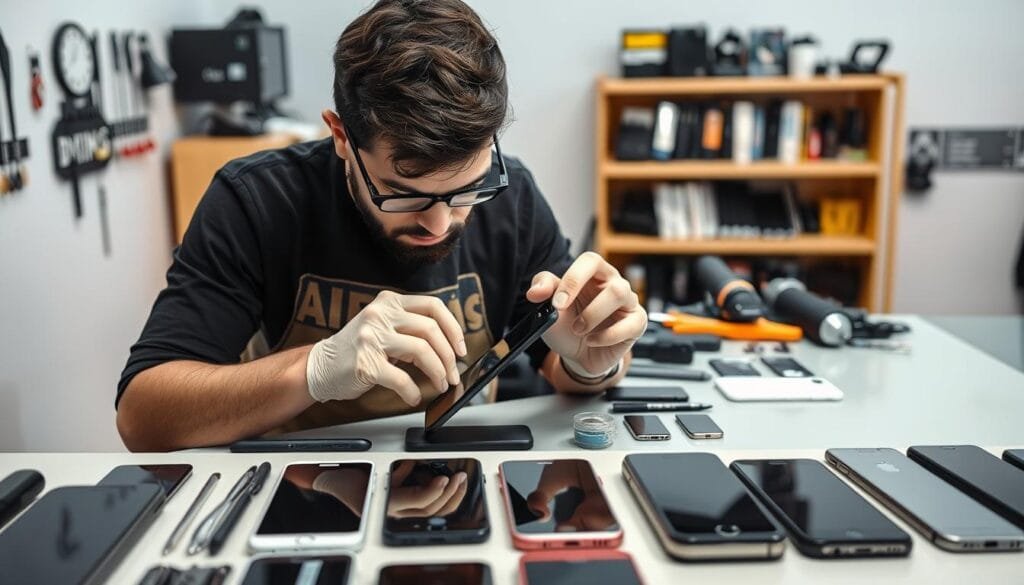5 Common Phone Problems and How to Fix Them in Ascot
December 25, 2024 | by search.wizards.info@gmail.com

One of the most common problems that smartphone users encounter is battery drain. This can be a frustrating issue, as it can significantly impact the usability of the device. There are several potential causes of battery drain, including background apps running, excessive screen brightness, and poor battery health. In some cases, a software update or reset may be necessary to resolve the issue. Additionally, using a power-saving mode or investing in a portable charger can help mitigate the effects of battery drain.
Another potential cause of battery drain is a faulty charging cable or port. If the charging cable is damaged or the port is dirty, it can prevent the device from charging properly, leading to rapid battery drain. In this case, cleaning the charging port with compressed air or replacing the charging cable may be necessary to resolve the issue. It’s also important to ensure that the device is not exposed to extreme temperatures, as this can also impact battery health and lead to rapid drain.
Slow Performance and Freezing
Another common issue that smartphone users encounter is slow performance and freezing. This can be caused by a variety of factors, including a lack of available storage space, outdated software, or a high number of background apps running. To address slow performance and freezing, it’s important to regularly clear the device’s cache, delete unnecessary files and apps, and install software updates as they become available. Additionally, closing background apps and restarting the device can help improve performance.
In some cases, slow performance and freezing may be indicative of a more serious hardware issue, such as a failing processor or insufficient RAM. If software solutions do not resolve the issue, it may be necessary to seek professional assistance to diagnose and repair the problem. It’s also important to ensure that the device is not exposed to extreme temperatures, as this can impact performance and lead to freezing.
Connectivity Problems
Connectivity problems are another common issue that smartphone users encounter. This can include issues with Wi-Fi, Bluetooth, and cellular connectivity. In some cases, connectivity problems may be caused by a weak signal or network congestion. To address these issues, it’s important to ensure that the device is within range of a strong signal and that network settings are configured correctly. Additionally, restarting the device or toggling airplane mode on and off can help resolve connectivity issues.
In some cases, connectivity problems may be caused by a software bug or compatibility issue. In this case, installing software updates or resetting network settings may be necessary to resolve the issue. If connectivity problems persist, it may be necessary to contact the device manufacturer or service provider for further assistance. It’s also important to ensure that the device’s antennas are not damaged or obstructed, as this can impact connectivity.
Overheating
Overheating is a serious issue that can impact the performance and longevity of a smartphone. This can be caused by a variety of factors, including excessive processor usage, exposure to high temperatures, or a faulty battery. To address overheating, it’s important to ensure that the device is not exposed to direct sunlight or extreme temperatures for extended periods of time. Additionally, closing background apps and avoiding processor-intensive tasks can help mitigate overheating.
In some cases, overheating may be indicative of a more serious hardware issue, such as a failing battery or damaged internal components. If software solutions do not resolve the issue, it may be necessary to seek professional assistance to diagnose and repair the problem. It’s also important to ensure that the device is not covered by a case or obstructed by other objects, as this can impact heat dissipation and lead to overheating.
Cracked Screen
A cracked screen is a common issue that smartphone users encounter, particularly if the device is dropped or subjected to impact. A cracked screen can significantly impact the usability of the device and may pose a safety risk if left unaddressed. In some cases, a cracked screen may be purely cosmetic, while in other cases it may impact touch sensitivity or display functionality. To address a cracked screen, it’s important to seek professional assistance to assess the extent of the damage and determine the best course of action.
In some cases, a cracked screen may be covered by a warranty or insurance plan, in which case repair or replacement may be covered at little to no cost to the user. If this is not an option, seeking out a reputable repair service may be necessary to address the issue. It’s also important to ensure that the device is protected by a durable case and screen protector to mitigate the risk of future damage.
Water Damage
Water damage is another serious issue that can impact the functionality and longevity of a smartphone. Exposure to water can cause corrosion and short-circuiting of internal components, leading to irreversible damage. If a smartphone has been exposed to water, it’s important to act quickly to mitigate the damage. This includes powering off the device immediately, removing any protective cases or accessories, and drying the device with a soft cloth.
In some cases, placing the device in a bag of uncooked rice or using a desiccant packet can help absorb moisture and mitigate damage. However, it’s important to note that these methods are not guaranteed to resolve water damage and seeking professional assistance may be necessary. It’s also important to avoid using heat sources such as hair dryers or ovens to dry the device, as this can cause further damage.
Software Glitches
Software glitches are another common issue that smartphone users encounter. This can include issues with app crashes, unresponsive touchscreens, or error messages. In some cases, software glitches may be caused by outdated software or incompatible apps. To address software glitches, it’s important to regularly install software updates and ensure that apps are compatible with the device’s operating system.
In some cases, software glitches may be indicative of a more serious software bug or hardware issue. In this case, performing a factory reset or seeking professional assistance may be necessary to resolve the issue. It’s also important to ensure that the device has sufficient available storage space and that background apps are closed to mitigate software glitches.
In conclusion, smartphone issues such as battery drain, slow performance, connectivity problems, overheating, cracked screens, water damage, and software glitches are common problems that users encounter. By taking proactive measures such as installing software updates, using protective accessories, and seeking professional assistance when necessary, users can mitigate these issues and prolong the usability of their devices.
RELATED POSTS
View all


 Choose repair by clicking (book now)
Choose repair by clicking (book now)